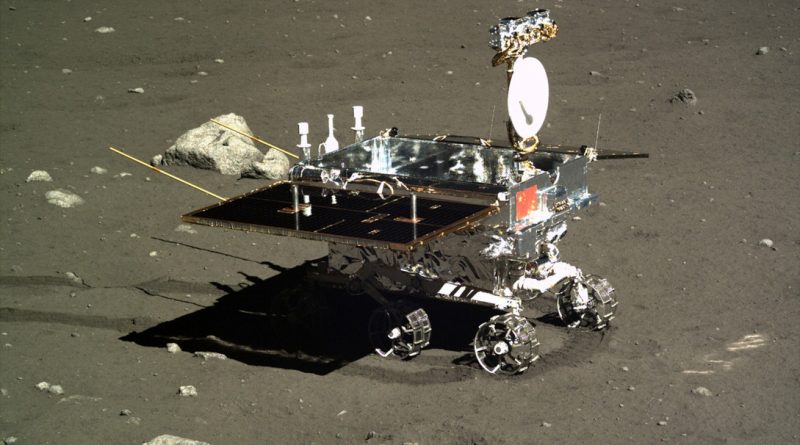Chinese Yutu Moon Rover pronounced Dead after record-setting Mission
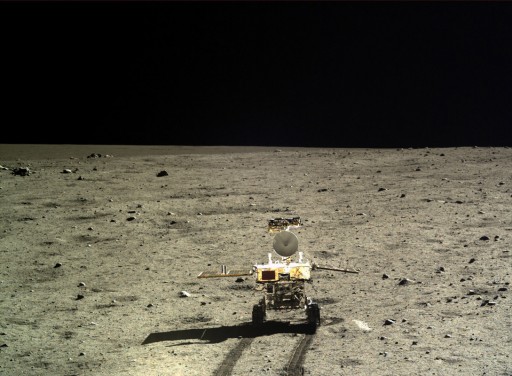
China’s Yutu rover exploring the lunar surface has stopped operating after a record-setting mission of 31 months, the State Administration for Science, Technology and Industry for National Defense (SASTIND) announced.
The “Jade Rabbit” – fastened to the Chang’e 3 lunar lander – embarked on a two-week flight to the Moon on December 1, 2013, lifting off atop a Long March 3B rocket. Chang’e 3 made a successful powered landing at Mare Imbrium on December 14, dispatching the small 120-Kilogram rover to the surface within hours of the landing.
Chang’e 3 was the first craft to complete a soft landing on the Moon in nearly four decades.
Having arrived on the lunar surface, the Yutu rover began an exploration mission expected to last three months while the Chang’e 3 lander was planned to endure the lunar environment for one year, using an Lunar-based Ultraviolet Telescope (LUT) to study the star-filled sky in the UV wavelengths and an Extreme UV Camera to examine Earth’s Plasmasphere.
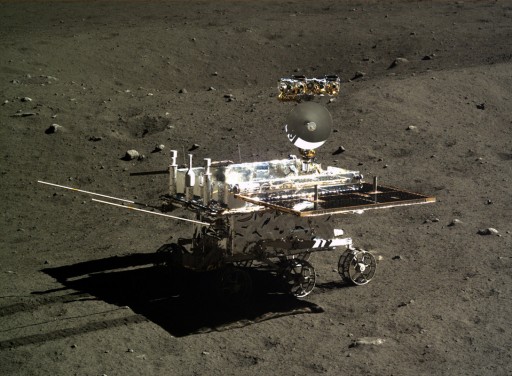
Remote controlled by the Mission Team in China, Yutu covered over 100 meters on the lunar surface, studying a variety of rocks using a suite of instruments comprised of panoramic cameras, a ground-penetrating radar, an imaging spectrometer and a robotic arm outfitted with an Alpha-Particle X-Ray Spectrometer.
The surface environment on the Moon poses a particular challenge to long-duration missions as day and night change only every two weeks with extreme cold in the dark of night and very hot temperatures during the day.
Yutu was feared dead at the end of its second lunar day in late January 2014 when it encountered a massive systems breakdown, rendering the craft immobile – unable to drive and no longer able to move its camera mast and solar panels, the latter of which presented the greatest challenge as one of the panels was used to shield the rover body from the harsh temperatures of lunar night.
To the surprise of many, Yutu woke up in mid-February when sunlight hit its solar arrays and began charging the rover’s batteries. However, it was determined that the Jade Rabbit would remain stationary for the rest of its life on the Moon without the ability to actuate its moving parts.
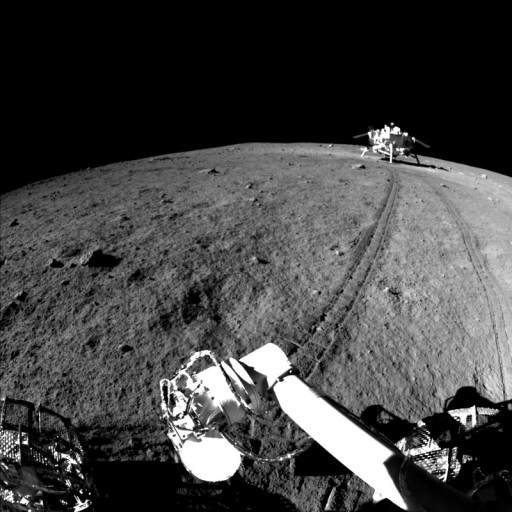
Despite its severely impacted functions, Yutu’s core systems and communications terminal continued functioning throughout 2014 and 2015, allowing the stationary rover to become the longest working rover ever deployed to the lunar surface. Mission Controllers decided to operate the rover for as long as possible to study the response of its different systems to the challenging environment on the Moon.
Signals from Yutu could be received by radio operators on Earth almost every lunar day as the Chinese mission team kept operating the rover to learn valuable lessons for future robotic missions to the Moon and other targets.
Yutu’s mission came to an end after 972 days when the rover became unresponsive to calls from the ground, having surpassed its intended lifetime and setting a new record for the longest operating rover on the lunar surface.
Meanwhile, the 1,200-Kilogram Chang’e 3 lander is still going strong, operating well beyond its expected one-year primary mission.
The mission so far has delivered over 100 scientific papers including new discoveries such as a previously unknown lava flow, a new type of basalt not seen in returned Apollo rock samples, and findings on the composition of the tenuous lunar exosphere.
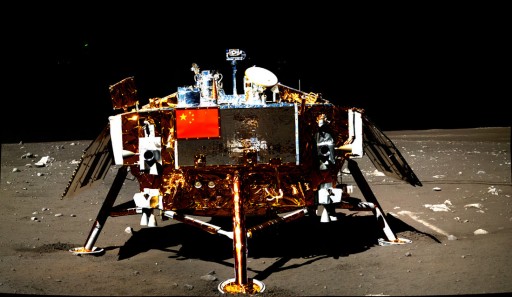
Papers released by the mission provide an extensive look at the mineralogy and composition of an impact crater and associated ejecta visited by Yutu. The investigation of freshly exposed material (on a geologic timescale) provided insights into the composition of younger lava flows on the Moon which has implications for the understanding of the late stages of active volcanism on the Moon. At the site, Yutu put to use its X-Ray Spectrometer and Visible and Near Infrared Imaging Spectrometer to examine the crater ejecta and regolith.
Scientists conclude that the material studied by Yutu represents a new type of basalt that differs from mare basalts that were previously sampled and returned to Earth by the Apollo missions. Data from the spectrometers indicates that the regolith is rich in titanium dioxide as well as iron and magnesium oxides, iron-rich olivine and minerals with high calcium content. This composition suggests that the regolith in this area was formed in the late stages of magma-ocean differentiation when dense mineral accumulations sank in the liquid magma phase and mixed with deeper minerals from the mantle.
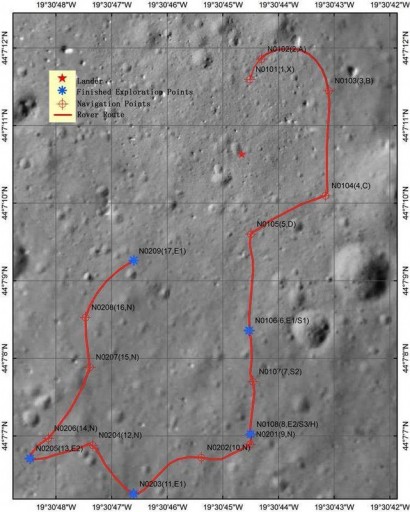
Earlier scientific findings of the Chang’e 3 mission revealed that the landing site inside Mare Imbrium was a basalt stratum with a high-titanium concentration, formed 3.2 to 1.1 billion years ago. Peering below the surface with its radar, Yutu data suggests that the regolith layer around the landing site is 4 to 6 meters thick. This regolith layer has been found to show irregularities with multiple layers of different thicknesses Below is a layer of lunar rock extending more than 300 meters in depth, likely a result of basaltic accumulation in the lunar mare.
Another paper details how the Lunar-Based Ultraviolet Telescope was used to determine the concentration of OH radicals in the tenuous lunar exosphere and the lunar surface as well as the concentration of neutral magnesium and aluminum through analysis of the diffuse background of 498 LUT images. It is noted that the upper limit for the exospheric OH radical concentration as determined by LUT is considerably lower than values previously calculated from data provided by the Indian Chandrayaan-1 orbiter and Hubble Space Telescope low resolution spectroscopy.
These low upper limits of the exospheric OH radical column density favor the sputtering theory of OH radical and water molecule release into the exosphere. According to this model, OH and water molecules are chemically adsorbed in silicate rock particles, but can be released through sputtering by the high-energy protons of the solar wind, leading to an increase of OH/water content in the exosphere on the dayside which is supported by previous measurements.
China’s lunar ambitions will continue in 2018 with the launch of as many as three missions – a relay satellite to deliver communications from the far side of the Moon for the Chang’e 4 mission which will closely resemble Chang’e 3 involving a lander and rover, but operating on the far side of the Moon to cover uncharted territory not yet explored by a surface mission. Chang’e 5, also set for liftoff in 2018, will be a sample return mission to deliver entire drill core samples to Earth.

